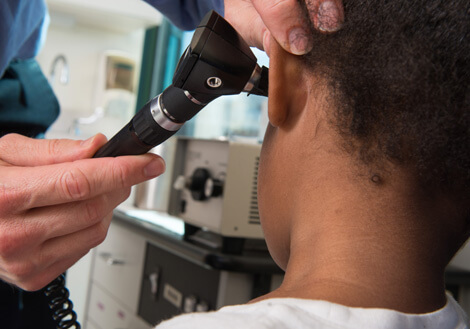Ear Conditions

Ear Conditions

Acute and chronic ear infections
-
Acute otitis media (AOM): The middle ear (space behind the ear drum) is infected and swollen. The eardrum itself is inflamed and pus is trapped behind the eardrum.
-
Otitis media with effusion (OME): Fluid temporarily stays trapped behind the eardrum in the middle ear space without signs of infection. This may happen after an acute ear infection has been treated or exacerbated by viral upper respiratory infections, allergies, or exposure to irritants such as cigarette smoke.
-
Chronic otitis media with effusion (COME): Fluid remains in the middle ear for a long time (months) or returns over and over again, even though there is no infection.
Complications of ear infections
If ear infections are not treated in the proper time frame, several conditions can occur:
-
Hearing loss/ Imbalance
-
Temporary weakness of the muscles of the face
-
Swelling of the mastoid bone behind the ear
-
Swelling of the meninges or lining of the brain
-
Collection of pus in the brain
-
Collection of pus beneath the skin behind the outer ear and involving the superficial layer of the mastoid bone
Conductive hearing loss
Ossicular dysfunction
Hearing loss due to the inability of sound vibrations to reach the inner ear hearing organ (cochlea). This includes problems with the external ear shape or ear canal, such as wax impaction or infection; problems with the eardrum, such as scarring or a perforation (hole); or problems with the middle ear, such as fluid, a cholesteatoma, scarring or separation of the three tiny hearing bones.
Eardrum perforations
A hole or rupture in the eardrum, a thin membrane that separates the ear canal and the middle ear, is called a perforated eardrum. The medical term for eardrum is tympanic membrane. The middle ear is connected to the nose by the eustachian tube, which equalizes pressure in the middle ear. A perforated eardrum is often accompanied by decreased hearing and occasional discharge. Pain is usually not persistent. Learn how to care for your child with an eardrum perforation.
Mastoiditis
Infection spreads beyond the middle ear space to affect the mastoid bone of the skull (bone felt behind the ear). This bone may then fill with infected material and lead to a more severe infection.
Cholesteatoma
A collection of skin and debris that forms a cyst behind the eardrum. This growth causes erosion of the hearing bones and can lead to several problems including hearing loss and chronic drainage from the ear. Surgery is required to treat this condition.
Ear tubes
Ear tube placement is a common surgery for children. Watch the video below to find out how to care for your child after ear tube placement surgery. Some children may still get ear infections with ear tubes. Learn more about how to treat ear infections with ear tubes.
